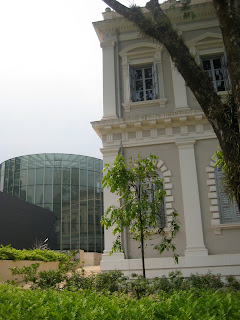

Beyond its initial modern entrance lies a much more ancient interior, as if we had crossed through time to view our history. The atrium walls are lined with neo-classical windows rarely seen in Singapore’s modernized architecture. Together with the rotunda dome containing 50 pieces of stained glass, each measuring nine feet long, one gets to soak into our rich architectural history, yet still keep in view the modernized blend of metal and glass.
The first floor of the museum houses the permanent exhibitions, namely the Singapore History Gallery and the Living Galleries. With the aid of modern technology, the galleries bring to us our history in an interactive mixture of videos, interactive displays and enriching voice recordings. Guided by a handheld companion, an electronic guide with audio, visual and textual information on the various exhibits in the History Gallery, the advanced technology that blended together to recreate history was almost an ironic tease to the visitor.

The History Gallery housed artifacts on Singapore’s history; her humble beginning, her founding, her colonial days, her days of the Japanese occupation and her road to independence. The combination of visual and audio effects brings forth a fresh outlook into Singapore’s past, a treat for both locals and foreigners alike.
The Living Galleries consists of four specialized galleries that gives us a more in dept look into Singapore’s rich cultural diversity. The four galleries, the Food, Fashion, Family and Photography Galleries delve into the details of Singaporean culture, providing us with nuggets of knowledge not commonly heard of.

Take for example the Fashion Gallery, a walk through the different fashion statements that dominated Singaporean history. From polka dotted dresses to flowing white wedding gowns, each display case shows us a new quirky fashion sense. The heavy cultural influences of our multi-racial background can be evidently seen in many of the clothes, bringing out our multi-racial identity in the most unusual of places.
A must see for all, the National Museum of Singapore brings history alive, literally throwing us back through time. Much can be learnt from a look at our history, not only plain facts about Raffles and Lee Kuan Yew, but also of grueling days spent, of hardships endured and of accomplishments well deserved. Packed into a mere 18,400 square feet, this venture into our past is not to be missed.

























